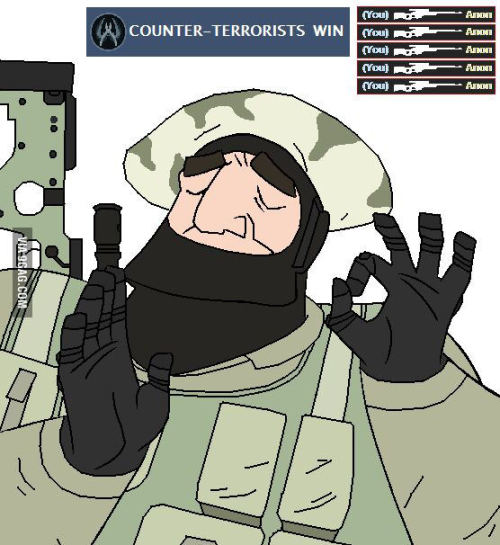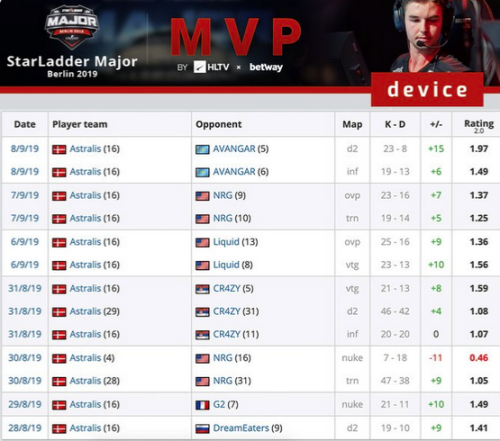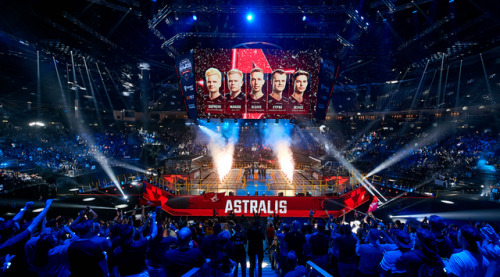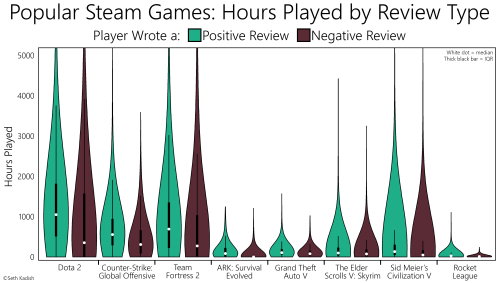#counter strike
Let’s go back in time just over ten years ago when the console war between big names like Sony, Microsoft, and Nintendo, raged in a great offensive to contrast the dominant PC base back then. A bit of history here trying to refresh the memories of gamers and non-gamers. Until the first half of 2000s PC titles were displaying the top shelves at your local Gamestop with their thick boxes as the DVD format became a standard pushing for bigger titles. At the same time console were still expanding and learning the consumer behavior of the players, but games had still little to no cross-platform so they were created for dedicated hardware.
Fast-forward today and everything is gone: video game stores have been closing with the advent of online platform like Steam and other outlets. But this is just the beginning of a new story that takes place online, where the face of gaming has been changing drastically so far. Gamers are now experiencing a whole new and different scenario of title quality and gameplay.
In the second decade of the 21st century a new different method of gaming has spawned and has been successful. Players have been shifting from purchasing a fully finished game inside a box to a platform of entertainment made of unfinished programming. Triple A titles have taken the habit of being release with the intent purpose of achieving their entirety through continuous purchases from the players. You are now getting sold video games that are meant to be consumed above their original price tag.

A funny yet realistic accountability of the gaming situation…
The rise of partially executed software for PC and eventually consoles has become (unfortunately) a common practice to yield more profit for the developers and the publishers. You are now getting the original title at a 80% out of its 100% so the remaining can be delivered to you in the following:
- deluxe game edition
- expansion
- retailer exclusive
But this is not the end. This is the norm now, the rest has become a much deeper problem in the last years that is costing gamers more than they originally paid for the game they wanted. Today micro-transactions of all kinds are the standard meal for the top gaming tears, which includes EA, Valve, Blizzard, Activision, Ubisoft, and neighbors.
Off course, nobody is pushing players to open their wallets to include more digital content; however, the situation shifted from adding something extra to adding something that should have been there since the beginning, to adding something needed. The easiest analogy that comes to mind is when someone purchasing a car at the dealership is paying more for features that aren’t includeden the standard package; fair enough and everybody agrees with it. But now it has come to having to pay more to have the air conditioning and the windshield: you can still use your car but it’ll be very uncomfortable without those two necessary items.

The apex of this phenomena translated after the release of Counter Strike: Global OffensivewhenValve included its reward system of loot in the shape of a crate, which needs a key to be opened and that key costs real money. Players have to add funds from their credit card to their virtual wallet in order to be able to open such crates, which contain for the majority items of very low value that are resold for pennies. On the other hand there’s the very low chance that a rare and high valued item might spawn, it can be sold on a virtual market on Steam for hundred of dollars making some people very happy and generating a system based on chances of getting what you wish for. At worst this is gambling, at best it’s dishonesty.
In 2016Washington State Gambling CommissiongaveValve until October of the same year to end their game skin gambling. This issue came with no surprise to me since I’ve been playing Counter StrikeandTeam Fortress 2 from their releases. It was clear that something was wrong if a gaming commission knocks at your door with official papers. Despite the court battle we cannot ignore the fact that millions of players around the world have poured millions of dollars in digital and extra content outside any original gaming release price.
What does all this mean?- It means that there’s a problem in the gaming community because there’s a behavior at play which entangles the user in sliding into a practice which has become far too common: paying to win. This translates into having a large chunk of players willing to use their credit cars to achieve a status which is not granted by simply purchasing the game, but rather adding real money in order to access the full intended game.
The latest scandal of uncomfortable micro-transactions and game addiction came in the form of uproar from the player base.EA pulls out their e-commerce of digital goods in the wake of online protest from Star Wars Battlefront 2. Winning upon paying? Sounds like that recently and for some times. Forms of favorable upgrades in gaming experiences are around to push the user into spending more to enhance the game quality. But the worst part if how casual EA executed the whole thing from the beginning by allowing this pay-to-win system to be released: purchase this item to easily win against other players and not by skill.
It’s worrisome that we have reached the slot machine level that Las Vegas does to enjoy what was just recently a standard gaming experience. Gambling forms of video games platform shouldn’t be there for players to go through, because this entertainment square is widely open to kids who are minors and don’t understand the concept of what gambling is and how does it work, especially when you allow it inside their favorite games. The line between fun and sorrow easily blurs and disappears.
Gaming addiction can only become worse when the legitimization of real money in video game gambling becomes the norm, which in part has been happening in the realm of digital products .I can only hope that game developers along publishers understand the basic relationship of digital entertainment: a virtual game for a virtual fun. That’s all.
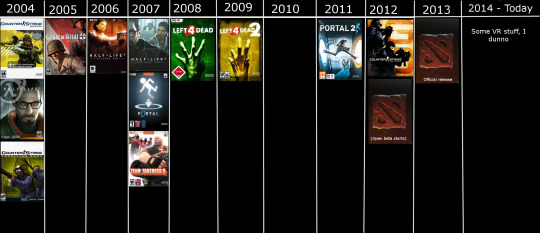
I recently found this chart on Reddit by u/Molotovn displaying the titles released by Valve since 2004 when Half Life 2 came out among the popularity of the FPS genre for PC games. Back in that period the publishing of the sequel to Half Life raised the bar for many other game developers not only in terms of aesthetics, but also for the experience the gameplay would offer.
Valve has a unique history that defies any other game developers in terms of name content but also on its major controversy of sequel spawn. Gamers have been waiting since 2007 for a Half Life 2 sequel in the shape of a episode installment or stand-alone title.
Meanwhile Valve has published other titles like Portal, Team Fortress 2, Left 4 Dead, Counter Strike: Global Offensive, and Dota 2. These titles all became international hits worldwide for their rich gameplay and extensive user-generated mods availability: you can play Half Life 2 or Left 4 Dead 2 with all the available perks to enjoy again a title coming out ten years ago.
Valve has been constantly criticized for its poor communication skills with their player base which left many people disappointed over the future of the Half Life destiny. The many rumors and leaks over the years condensed into an even more confusing direction Valve is secretly considering for this title: continuing or not continuing?
If we analyze the patterns of behavior Valve has taken in the last ten years we see they have slowly left the game developing practice in order to go towards the distribution side. Steam has become a significant yet unique publishing platform for all types of big and small games, followed by music and movie distribution.
Valve has been intensely working with the Virtual Reality platform for the past five years while the whole creative Half Life team has left the company. For many it was an omen of changing times while others remain faithful to a miraculous release of Half Life 3.
Steam has pioneered the online experience of a service providing game purchase at an advantageous price to fight piracy and the retail sector of hard copies. This system has become an OS within an OS and the SteamOS is available to users who want PC experience on the go with a console feel.
Valve has been smart managing its online identity ever since it became an official distributor of digital goods well before anybody else, including a personal interface for each player to manage with its content. Now it has become an empire of triple A titles as well as an important vault of indie games. Steam has given independent developers a voice for their products to be sold and admired, something the competition snubbed for lack of better foresight in game design.
I wouldn’t be surprised if Valve transforms itself into a multimedia distribution platform in the shape of Youtube/Twitch store, including the sale of the products it will eventually broadcast if the company decides to push for streaming rights. It seems as a logical deduction in the wake of the many shifts of broadcasting and sales rights the net has witnessed until today.
One thing we have to wait for is for international distribution rights to be granted along with specific contracts for each continental region. Laws and copyright restrictions still limit some deals of titles and contents as well of platform spreading in the Western World; any further expansion towards the east like China and the rest of Asia will still be something to monitor.
We can speculate that from here to 2020 Valve will make their biggest decision whether to continue to develop titles of their own or to fully become an international distribution platform; something totally new that will defy the rules of digital share we have today.
CS:GO community be like
Hi there, I’m looking for gaming blogs to follow.
Reblogging would help, if you have a bunch of gaming blogs that follow you too - but just liking is enough for me to check it out.
I put some of my favorite games as tags.
General gaming blogs, mixed in with humor blogging, that have a bunch of different content would be perfect.
But if you’re just a blog dedicated to one game, especially if it’s in the tags, is okay too. :)
Just send me an ask if there’s a specific blog you like and would like me to follow.
Thanks guys!

TUMPOK
Digital Art by Gerilya
2021
Astralis is totally dominated by Inferno. AVANGAR started poorly, he barely managed to win 3 rounds as CT,
Ali only killed one player in Astralis… After the break the Kazakh team won the guns but even on their favorite map they were weak. they had no chance. Astrlis didn’t even have to reach the heights of their skills.
Tournament players have been selected dev1ce
Post link

Much better than Team Fortress …
While browsing games on Steam the other day, I noticed that many gamers who have recorded thousands of hours on a given game don’t recommend it (i.e., they provide negative reviews). This could be for a variety of reasons: they don’t like the game, they liked it but something changed and now they don’t like it anymore, or they do like it but are being funny. Many people change their review from positive to negative due to a glitchy update, charging for mods, increasing the game price (then offering it on sale for the original price), or having too many hackers in the community.
I pulled 3,000+ reviews for each game (1,500+ positive and 1,500+ negative) to create these distributions of hours played by review type. There were two exceptions (Rocket League and Civilization V) where there weren’t enough helpful negative reviews – in both those cases I used all the available negative reviews. The violin plots show the median (white dot), interquartile range (thick black bar), 1.5*IQR (thin black bar), and full range (extent of violin). I’ve limited the y-axis to 5,000 hrs, but many reviews came from players who logged far more – some reviews had over 15,000 hrs on a single game, which is impressive given that a year is ~8,766 hrs.
Of course, the violins show that gamers who recommend a game tend to play it for more hours. That said, the negative review distributions still show significant hours logged! Let’s all try to remember that we play video games because we enjoy them – if they stop being fun, it’s probably time to stop playing.
Data source: http://store.steampowered.com/
Post link


